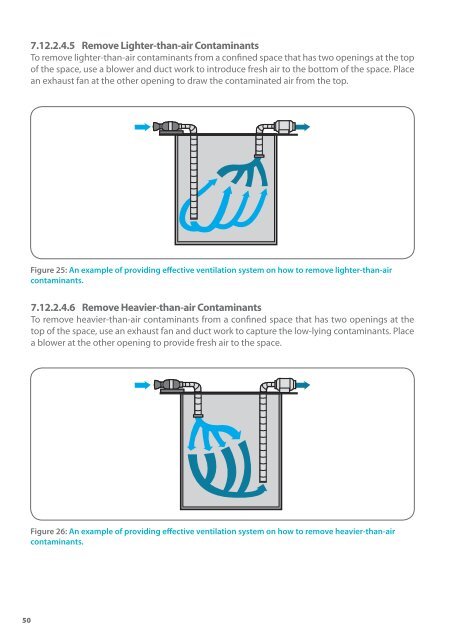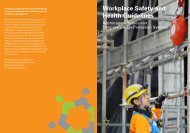Confined Spaces - Workplace Safety and Health Council
Confined Spaces - Workplace Safety and Health Council
Confined Spaces - Workplace Safety and Health Council
- No tags were found...
Create successful ePaper yourself
Turn your PDF publications into a flip-book with our unique Google optimized e-Paper software.
7.12.2.4.5 Remove Lighter-than-air ContaminantsTo remove lighter-than-air contaminants from a confined space that has two openings at the topof the space, use a blower <strong>and</strong> duct work to introduce fresh air to the bottom of the space. Placean exhaust fan at the other opening to draw the contaminated air from the top.8. Emergency And Rescue ProceduresBefore anyone is authorised to enter a confined space, it is crucial to have trained emergencyrescue personnel available when an entrant needs help. It is important for such personnel toreach the site promptly <strong>and</strong> know how to deal with the emergency.In any unplanned rescue, such as when someone instinctively rushes in to help a downedco-worker, it can easily result in a double fatality or even multiple fatalities if there are more thanone would-be rescuers.REMEMBER: An unplanned rescue will probably be your LAST.Figure 25: An example of providing effective ventilation system on how to remove lighter-than-aircontaminants.7.12.2.4.6 Remove Heavier-than-air ContaminantsTo remove heavier-than-air contaminants from a confined space that has two openings at thetop of the space, use an exhaust fan <strong>and</strong> duct work to capture the low-lying contaminants. Placea blower at the other opening to provide fresh air to the space.It is “A MUST” to have a written <strong>and</strong> established rescue operation plan on-site that includesequipment, such as retrieval devices, breathing <strong>and</strong> resuscitating apparatus, ready for emergencyuse immediately. The severity of accidents can be reduced with timely alerts from attendantsoutside the confined space. A well-trained <strong>and</strong> fully equipped rescue team can ensure a speedyresponse in an emergency.8.1 Establishment of Rescue Operation PlansA written rescue operation plan shall be established for the purpose of rescuing persons in aconfined space. The rescue operation plan shall:• Have names of the designated rescue personnel available;• Indicate the methods of rescue to retrieve persons inside a confined space;• Prescribe the types <strong>and</strong> availability of equipment necessary for rescue; <strong>and</strong>• Provide an effective means to summon the designated rescue personnel in a timely manner.8.2 Rescue ArrangementsThe risk assessment will determine what rescue arrangements are necessary. The arrangementswill depend on the nature of the confined space, the risks identified <strong>and</strong> the types of emergencysituations which are foreseeable. It is important to note the possible emergencies in the confinedspace, <strong>and</strong> any other foreseeable accident for a rescue operation. For example, the incapacitationof a person, wholly or partially, following a fall inside a confined space.Figure 26: An example of providing effective ventilation system on how to remove heavier-than-aircontaminants.Possible confined space rescue strategies include the following:• Self-rescue when the circumstances, the nature of the hazards <strong>and</strong> the control measuresavailable allow;• Rescue by team members (trained rescue personnel) using non-entry methods if feasible;• Rescue by team members (trained rescue personnel) using a safe entry technique; <strong>and</strong>• Rescue using a safe entry technique by the local public emergency services subject toadequate time being available (this depends on the nature of the hazards <strong>and</strong> the responsetime of the emergency services).50 51
















